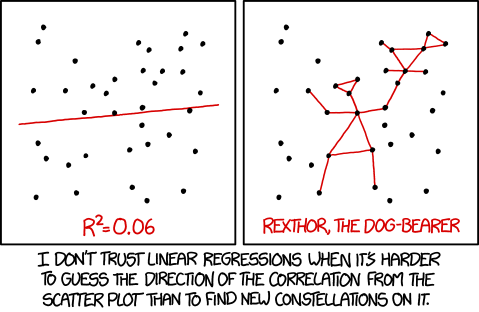Title of Slides
Lecture \(n\) - CODE10001
Placeholder
This slide is split into two columns, one with a list and one with an image from the web.
- List item A,
- List item B,
- List item C,
- Final list item.

To access the speaker notes for these slides, tap s on your keyboard.
To export the slides, tap e and then print to PDF.
Example Section
Maths
Equations are formatted with \(\mathrm{\LaTeX}\), either inline with $...$ or centred with $$...$$.
Theorem: Quadratic Equation
If \(ax^2 + bx + c = 0\) where \(a\neq0\), then the solutions are given by \(x = \frac{-b \pm \sqrt{b^2 - 4ac}}{2a}\).
Proof
\[\begin{align} ax^2 + bx + c &= 0 \\ 4a^2 x^2 + 4abx + 4ac &= 0 \\ 4a^2 x^2 + 4abx + b^2 &= b^2 - 4ac \\ {(2ax + b)}^2 &= b^2 - 4ac \\ 2ax + b &= \pm\sqrt{b^2 - 4ac} \\ 2ax &= -b\pm\sqrt{b^2 - 4ac} \\ x &= \frac{-b\pm\sqrt{b^2 - 4ac}}{2a} \\ \end{align}\]
Note
This is Śrīdhara’s method. The steps of the derivation are:
- Multiply both sides by \(4a\).
- Add \(b^2 - 4ac\) to both sides.
- Complete the square on the left hand side.
- Take the square root of both sides.
- Subtract \(b\) from both sides.
- Divide both sides by \(2a\) (since \(a\neq0\)). \(\square\)
Nice Plots
Given response \(y\) and single predictor \(x\), this model fits to the equation
\[\begin{equation} y = \beta_{0} + \beta_{1}x. \end{equation}\]
Visually, the line of best fit from linear regression may look like the below.
Code Output
If we roll a dice 30 times, how many threes would we expect to get?
Theoretical Outcome
The \(\mathbb{P}(X=3) = \frac{1}{6}\). Therefore we expect to get \(30\times\frac{1}{6} = 5\) threes.
In practice, it probably won’t be exactly that many.

[1] 3 1 3 2 6 1 4 5 5 3 6 2 1 1 5 3 1 6 1 6 4 6 2 4 1 2 4 1 4 5